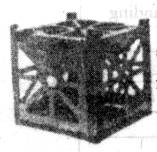In June, 2007, a group of students from eight high schools in Winnipeg, the capital of Canada’s Manitoba province, will begin test-launching (试发射) a satellite the size of a Rubik’s cube.

The one-kilogram Win-Cub satellite, named for its home city and its shape, will be put into low orbit. Once in space, it can perform for a few months or up to several years, communicating information that could help find the signs of earthquakes.
There are 80 similar satellite projects worldwide, but this is the first high-school based program of its kind in Canada. 30 Manitoba high school students are having a hand in designing and building the satellite, in cooperation with aerospace (航空航天的) experts and 10 students from the University of Manitoba, and with support from two other organizations.
The Win-Cube project is not something that goes on a piece of paper; it is real-world engineering, allowing high school students to have an opportunity to learn more about the exciting world of engineering through their participation in this challenging program. It is also taken as a wonderful example of the unique partnerships within Manitoba. Designing, building and launching a satellite with high-school participation will bring this world-class educational project into reality and Manitoba closer to space.
“These Manitoba high school students deserve congratulations for their enthusiasm, innovation (创新), and a strong love for discovery,” said Education, Citizenship and Youth Minister Peter Bjomson. “We want to make science more relevant (相关的), interesting and attractive to high school students by showing them how classroom studies can relate to practical experience in the workplace or, in this case, in space,” Bjomson added.
The Win-Cube program is mainly named at inspiring a strong desire for discovery on the part of the students. It also shows Manitoba’s devotion to research and innovation and the development of a skilled workforce—all important drivers of knowledge-based economic growth.
1. According to the passage, the Win-Cube satellite is _________.
A. named after Manitoba and its shape
B. intended for international communication
C. designed like a Rubik’s cube both in shape and size
D. challenged by university students around the world
2. According to Mr. Bjomson, ___________.
A. those Manitoba high school students are worth praising
B. the study of space can be practically made in classrooms
C. Manitoba high schools are famous for the study of space
D. scientific research is too far away from high school students
3. The primary purpose of the project is to _________.
A. find the early signs of earthquakes
B. relate studies to practical
C. help high school students study real-world engineering
D. inspire a strong desire for discovery among the students
4. The best title for this passage may be ________.
A. Manitoba School B. Win-Cube Program
C. Space Co-operation D. Satellite Launching
